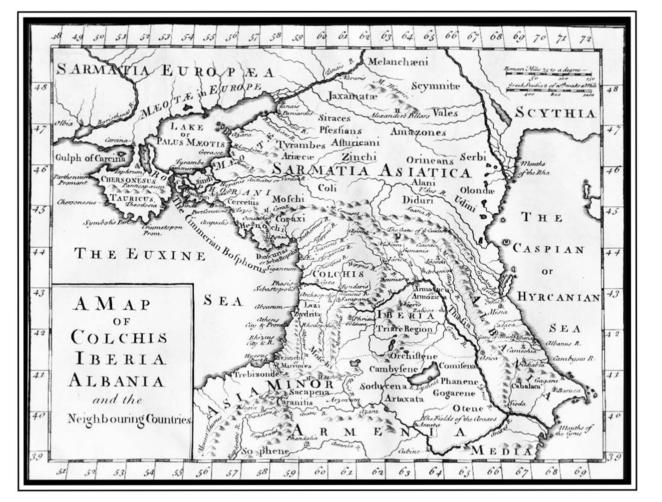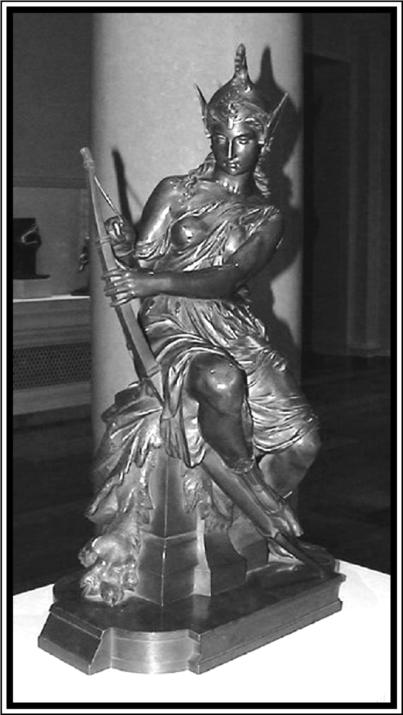Hidden History: Lost Civilizations, Secret Knowledge, and Ancient Mysteries (42 page)
Read Hidden History: Lost Civilizations, Secret Knowledge, and Ancient Mysteries Online
Authors: Brian Haughton
Tags: #Fringe Science, #Gnostic Dementia, #U.S.A., #Alternative History, #Amazon.com, #Retail, #Archaeology, #History


Map of supposed Amazon homeland, produced in London, c. 1770.
For perhaps 3,000 years, the idea
of a tribe of fierce warrior-women inhabiting the edge of the known world
has captured our imagination. From
ancient Greek and Roman writers of
myth and myth-history, right up to
modern television shows such as Xena:
Warrior Princess, this war-like,
women-only society has been constantly reinvented to suit the time and
the place. But is there something tangible, or even historical, behind these
stories and legends?
We first hear of the Amazons as a
tribe of warrior women in the Iliad,
Homer's epic tale about the Trojan
War, probably written in the eighth
century B.C. Here they are briefly mentioned as having attacked Priam of
Troy while he was campaigning in central Turkey. Homer describes these
women as "those who fight like men."
After Homer, many Greek writers
added more elements to the Amazon
character and supposed origin. The
Greek historian Herodotus, writing around the middle of the fifth century
B.C., called them Androktones (killers
of men), and has an interesting (in the
light of recent archaeological discoveries) story to tell about them. After
being beaten by the Greeks at the
battle of Thermodon, in northern Turkey, Amazon prisoners of war were
taken back to Greece by ship. During
the journey, they attacked and killed
their captors, but were incapable of
sailing the boat, and drifted northwards across the Black Sea. They
eventually landed on the shores of
Scythian territory, where they stole
horses and began raiding the area.
Herodotus describes the Amazons
reaching an agreement with the
Scythians, a loose network of horseriding nomadic steppe tribes, and subsequently intermarrying with the men.
Afterwards they moved northwards
and settled east of the Don, in what is
now southern Russia, where they ultimately evolved into the Sauromatian
culture. Another story, this time told
by Roman writers, involve the Amazons fighting as allies of Priam against
the Greeks in the Trojan War. Towards
the end of the war, after killing many
Greeks in battle, the Amazon queen
Penthesilea took the field against
Achilles, only to be slain in a bloody
duel. A number of other Greek heroes
also had life or death struggles with
these formidable women.
One of the 12 labors imposed upon
Hercules required him to obtain the
magic girdle of the Amazon queen,
Hippolyte. To fulfill this task, Hercules, in the company of another Greek
hero, Theseus, journeyed to the capital city of the Amazons, Themiscyra,
on the river Thermodon, on the south
ern shore of the Black Sea. Heracles
killed Hippolyte and obtained the
girdle, and Theseus carried off the
princess Antiope, one of Hippolyte's
sisters. In order to rescue Antiope, the
Amazons invaded Greece and attacked
Athens, but were defeated. In some
versions of the story, Antiope is cut
down fighting at the side of Theseus.
The mythical battles between the
Greeks and the Amazons were often
commemorated in a genre of Greek art
known as amazonomachy, one example of which, carved in marble,
comes from the Parthenon, in Athens.
Some biographers of Alexander the
Great mention him meeting with an
Amazon queen called Thalestris, and
her having a child by him, though this
is disputed by Greek historian and biographer Plutarch in his book, Life of
Alexander, as well as other ancient
writers.
Early Greek and Roman writers
associated various strange customs
with the Amazons. The very word
Amazon, thought now to derive from
the Iranian word ha-mazan (meaning
warrior), in the Greek version means
without breast. The Greeks probably
attached this meaning to the word to
explain a tradition that the Amazons
had their right breast burned or cut
off to facilitate the drawing of the bowstring. However, depictions of Amazons in Greek art always show them
with two breasts. Another myth describes how the Amazons did not allow men to live in their territory.
However, once a year, in order to sustain their race, they traveled to visit a
neighboring all-male tribe called the
Gargareans. Female children who resulted from this procreation were brought up by the Amazons, and
trained in agriculture, hunting, and
war, while males were either put to
death or given back to their fathers.
Amazons were associated with a
bewildering range of places, from the
Black Sea coast of Turkey to southern Russia, Libya, and even Atlantis.
In light of such far-fetched ideas, it is
not surprising that the consensus of
opinion about the Amazons is that they
are a myth. But recently, thanks to archaeology, scholarly opinions have been
changing. According to Herodotus, the
Sauromatian people of southern Russia were descendants of the Amazons
and the Scythians. Although Russian
archaeologists had been finding skeletons of female warriors in the Pontic
Steppe (the steppelands north of the
Black Sea extending east as far as the
Caspian Sea) since the mid-19th century, western scholars and archaeologists were either unaware of these
finds or had not made the connection
with the Amazons of Greek legend. Excavations conducted by Russian and
American archaeologists and led by
Jeannine Davis-Kimball (of the American-Eurasian Research Institute) have
suggested that these Greek stories
may have had some basis in fact. Ancient burial mounds (known as
kurgans) found near the town of
Pokrovka, near the Russian border
with Kazakhstan, have produced skeletons of women buried with weapons.
The burials included iron swords or
daggers, bronze arrowheads, bows,
quivers, and horse harnesses. The
graves date from the sixth to the fourth
century B.c., and indicate a culture
that included warrior women of high
status.

Photographer unknown.
(GNU Free Documentation License)
Amazon Preparing for Battle by PierreEugene-Emile Hebert. National Gallery of
Art, Washington, D.C.
Initially there were suggestions
that the weapons served a ritual purpose, but examinations of the skeletons have revealed otherwise. Some
of the skulls exhibit signs of wounds,
and bowed leg bones belonging to one
13- or 14-year-old girl indicate a life
on horseback. A bent arrowhead embedded in the knee of another woman
suggests a battle wound. The weapons
found with the women appeared to have seen frequent use in battle, and
they also had smaller handles than
those buried with the males, suggesting that they were made especially for
women. Could these then be graves of
the legendary Amazons? Probably not.
In one sense, Herodotus was rightthere are certainly Sauromatian
women warriors. However, there is no
evidence that they descended from the
Amazon-Scythian intermarriage mentioned in Herodotus' Histories. Another factor is that Sauromatian
women warriors only made up a relatively small proportion of the tribe.
While 90 percent of male burials were
warriors, only around 20 percent of the
women were buried with weapons.
There is another reason why it is
unlikely that the Sauromatians were
the source of the Amazon myths. Amazons were being depicted in Greek art
and literature as far back as the eighth
century B.C., at least 200 years before
there is any evidence of women warriors on the Eurasian steppe. The
earliest Greek colonies in the Black
Sea date from the seventh century B.C.,
though there were probably earlier
trading voyages. So although it is
just barely possible that female warriors existed on the steppe earlier
than current archaeological evidence
suggests-and that Greeks made contact with them-there is no evidence
for this contact. As it stands, the
women warriors of the Sauromatian
culture may have influenced the Amazon myth, but they could not have been
its source. Around the fourth century
B.C. the Sauromatian culture evolved
into the Sarmatian culture, another
nomadic tribe, and women warriors
are also found in early Sarmatian burials. The Sarmatians ranged much
further west than their predecessors,
and came into direct contact with the
Romans. In fact, Sarmatian cavalry, in
the service of Rome, were active in
Britain from the second to the fifth
centuries A.D. Whether these
Romanized cavalry included women
warriors is not known, however.
There are other examples of steppe
tribes that included women warriors,
one of which are the Pazyryk people,
another culture related to the
Scythians. Though the Pazyryks were
located a long way to the east of the
Sarmatians, in the Altai Mountains of
Siberian Russia, they had almost identical burial customs, using kurgans
similar to those found in the Ukraine
and southern Russia. A fifth century
B.C. Pazyryk kurgan-burial found in
1993 by Russian archaeologist Natalia
Polosmak has become known as the
Siberian Ice Maiden, although she was
not a warrior but a high-ranking
priestess. Polosmak did, however, find
a grave containing the skeletons of a
man and a woman, each buried with
arrowheads and an axe.
Perhaps it was traveler's stories of
the higher social standing enjoyed by
steppe women that added another,
more realistic, dimension to the already
existing Greek Amazon myths. In another way, the Amazons can be seen as
a mythical illustration of the dangersand perhaps the barbarism-of the unknown, which the Greeks faced when
venturing into new lands, such as the
Black Sea coast. It is interesting to
note that for the Greeks, the Amazons
always existed at the very edge of
the known world, on the fringes of
civilization. As the Greek world expanded, the homeland of the Amazons
was pushed further away, which is probably why the actual geography associated with them shifts around so
much. The earliest references begin
with the Amazons to the east of Greece
in Asia Minor (Turkey), supposedly
founding the cities of Ephesus and
Smyrna, on its eastern coast. By the
time of Herodotus (fifth century B.C.)
they had moved into southern Russia,
and when Diodorus of Sicily was writing his Library of World History in the
first century B.C., the Amazons were associated with western Libya.
If the Amazons myths are a
memory of a factual matriarchal culture of fighting women, an important
point to consider is that Homer wrote
in the eighth century about them as if
the audience was already familiar with
the topic. Thus they must have existed
earlier, probably somewhere in the
Late Bronze Age/Early Iron Age period
(between the dates c. 1600 B.C. and c.
900 B.C.). A location for the Amazons
either in Anatolia, the Russian
Steppes, or the Caucasus mountains,
seems the most likely. But for the moment at least, there is no evidence for
any warrior women at this early date
in these areas.
In one sense, the Amazon myth can
be viewed partly as how the Greeks
viewed the concept of the other. The
characteristics given to these women
in the literature and art of the time
are intended to demonstrate the opposite of everything possessed by a
normal society. In Greek society,
women's duties were on the whole confined to the home, and they did not
have any involvement in war or politics. In contrast, the Amazons made
their own decisions and fought their
own battles. Such reverse role myths
helped to support the status quo of
the Greek state by showing the unnaturalness of a society that was radically different from their own. And,
of course, when barbarism comes up
against culture-as in the case of the
many battles between Amazons and
Greeks-it loses.

